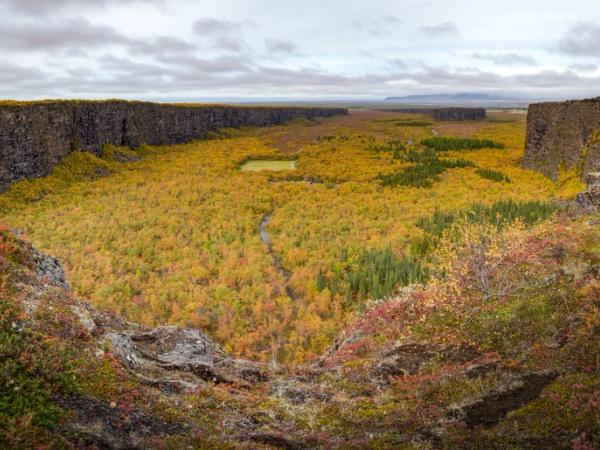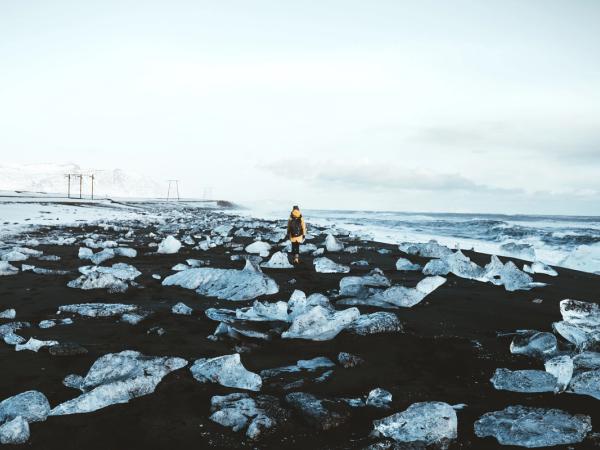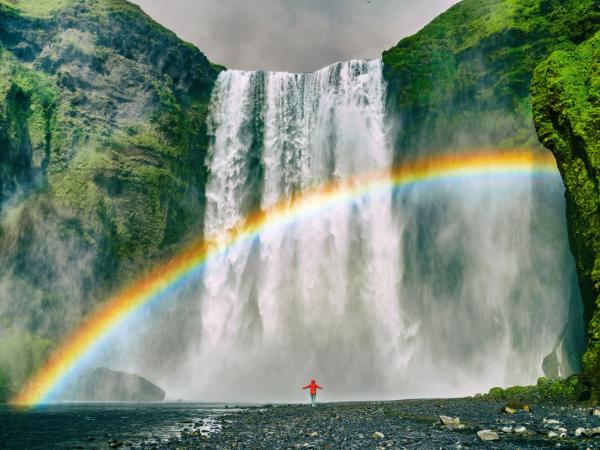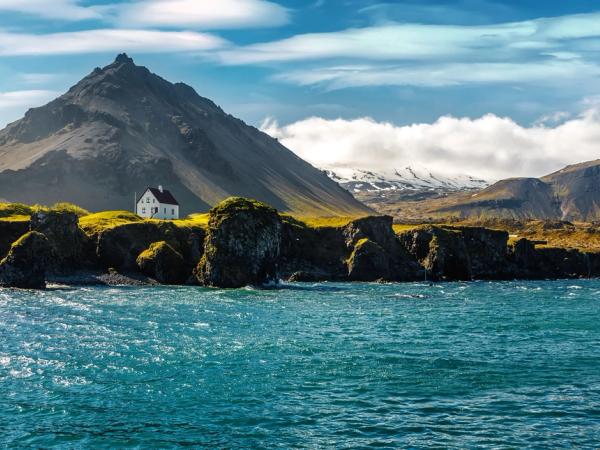
Summer in Iceland: Your Guide For An Unforgettable Trip
Imagine a land where the sun barely sets, illuminating some of the most amazing landscapes on the planet. Welcome to Iceland in summer, a season that transforms this Nordic country into a dream destination for visitors from all over the world. The island is full of waterfalls, volcanoes, geothermal areas, glaciers, and vibrant cities. And, without a doubt, summer is a fantastic time to come, as the weather is at its nicest and the daylight hours are really long, providing a lot of time to discover everything.
In this guide, we’re going to give you all the information you need to enjoy Iceland to the fullest at this time of the year. From what to expect, what to see and do, and other practical tips to make your trip unforgettable.
Key Takeaways
- Summer in Iceland spans from June to August.
- The average temperature ranges between 10°C and 15°C, and by the end of June, there are almost 24 hours of light per day.
- The roads in the Central Highlands, one of Iceland's most impressive regions, are only open during these months.
Advantages of coming to Iceland during the summer
All the seasons are great to visit Iceland. Each one of them has its pros and cons, as the climate affects the landscapes and things you can do here. However, summer provides the best conditions for exploring the natural monuments, as they are more favorable than the rest of the year.
The weather
Summer in Iceland, spanning from June to August, brings milder temperatures and extended daylight hours. In fact, by the summer solstice, around June 21st, the sun barely sets, providing almost 24 hours of natural light. Average temperatures range between 10°C to 15°C (50°F to 59°F), with occasional peaks reaching up to 20°C (68°F).
While the weather is generally more stable than in other seasons, it’s still unpredictable. It can change at a moment's notice, so it’s recommended to bring waterproof clothing because rain is common, especially in the south. The best way to adapt is to dress in layers. This way, you can adjust to the changes, removing or adding items if necessary.

Open roads
One of the significant advantages of visiting Iceland in summer is the accessibility to all the regions. The infamous F-roads (mountain roads) are open from mid-June to early September, allowing travelers to explore remote areas inaccessible for the rest of the year. This means you can venture into the heart of Iceland's rugged interior, discovering amazing landscapes that are impossible to see in other seasons.

Summer Weather by Region
The weather in Iceland varies a lot from region to region, so it's key to be well-prepared for different climates within the same trip.
- Reykjavik and the South: In the capital and southern areas, summer temperatures usually range between 50°F and 59°F (10°C to 15°C). These are the country's "warmest" areas. However, the wind can make it feel a bit cooler, so don't let it fool you.
- The North and Akureyri: If you venture north to places like Akureyri or Húsavík, temperatures can be slightly lower, hovering between 46°F and 55°F (8°C to 13°C). This region is known for having a somewhat drier climate, but it's just as changeable.
- The East and the East Fjords: The eastern region, including the East Fjords, enjoys a relatively mild and stable summer climate, with temperatures ranging from 48°F to 57°F (9°C to 14°C). It's a less touristy area featuring mountainous landscapes and impressive fjords. Here, precipitation is moderate, and it's common to find morning fog that clears as the day goes on.
- The West and the Westfjords: In the Westfjords, the climate is a bit cooler and more humid. Temperatures usually sit between 45°F and 54°F (7°C to 12°C). This is one of Iceland's most remote and wild regions, and the weather can be quite changeable. Rain and wind are frequent, but you'll also get to enjoy clear days with spectacular views of the fjords and mountains.
- The Highlands: Iceland's Highlands are a world of their own. Here, summer temperatures can drop to 41°F (5°C) and rarely exceed 50°F (10°C). Plus, the weather can change in a matter of minutes, so it's important to be well-prepared.
- Glacial Areas like Vatnajökull: If you're planning to visit glaciers like Vatnajökull, get ready for colder temperatures. Even in summer, you may encounter temperatures as low as 32°F (0°C). The wind and altitude can make it feel even colder.
What to Pack for Iceland in The Summer
- Layered Clothing: Bring thermal shirts, sweaters or fleece jackets, and a good waterproof and windproof jacket. This way, you can easily adapt to temperature changes.
- Water-Resistant Pants: Ideal for rainy days or outdoor activities where you might get wet.
- Hiking Boots: Comfortable, waterproof boots with good grip are essential, especially if you plan to explore places like Landmannalaugar or trek the Laugavegur Trail.
- Accessories: Don't underestimate the power of a hat, light gloves, and a scarf or neck gaiter. They're small but make a big difference, especially in colder or windier areas.
- Sunscreen and Sunglasses: It may seem odd, but the sun can be quite intense, especially with reflections off the water or glacier ice.
- Swimsuit: Yes, you read that right. Don't forget your swimsuit to enjoy hot springs like the Blue Lagoon or the natural pools in Reykjadalur.
- Waterproof Backpack or Backpack Cover: To protect your belongings from sudden rain.
- Insect Repellent: One of the best things about Iceland is that thanks to its climate, it doesn't have mosquitoes, so there's no need to bring repellent.

The Summer Months in Iceland
Each summer month in Iceland has its own vibe. Let me give you a quick rundown so you can pick the best time to visit.
June
June is when Iceland kicks off summer with the midnight sun—you'll get almost 24 hours of daylight! Temperatures range from 48°F to 59°F (9°C to 15°C), and everything is lush and green. It's the start of the tourist season, so fewer people are around, and prices might be slightly lower. Plus, June 17th is Iceland's National Day, so you'll find parades, concerts, and festivals—a great way to soak up the local culture.
It's also prime time for puffin watching since they return to nest. Some Highland roads start opening up, and festivals like Secret Solstice keep things lively.

July
July is peak summer in Iceland. Temps can reach up to 68°F (20°C) on sunny days. All the roads are open, including those to the Highlands and remote areas, so it's perfect for exploring everywhere. Just a heads up—it's the busiest month for tourists. If you're not into crowds, consider checking out the East and West Fjords or the Vestmannaeyjar Islands for stunning landscapes with fewer people.
There are a bunch of local festivals happening, with music, dancing, and traditional activities. Nature is at its best, making it ideal for hiking, camping, biking, and kayaking. Wildlife is super active, too, so it's a great time for whale and puffin watching.

August
August signals the shift from summer to fall, but the weather is still pretty nice, with temperatures between 46°F and 57°F (8°C to 14°C). The days start getting shorter, but there's still plenty of daylight for outdoor fun. Early in the month, there's the Merchants' Weekend (Verslunarmannahelgi), one of Iceland's biggest holidays filled with festivals and parties.
The cool thing about August is that toward the end of the month, you might catch the first glimpses of the Northern Lights if the skies are clear. It's also berry and mushroom picking season—a local tradition you can join in on. Tourist numbers start to drop, so things are a bit quieter. Just be prepared for more unpredictable weather, like possible rain and cooler days.

What to See in Iceland in Summer
The list of things to see in Iceland is almost endless, but we have selected some of the best you can see during the summer.
The Central Highlands
As we said before, one of the main perks of coming to Iceland between June and August is that you can go to this remote region. The Icelandic Highlands are a vast, uninhabited plateau with some of the country's most dramatic places. Accessible only during the summer months, this region is characterized by volcanic deserts, geothermal areas, and glacial rivers.
Some of the most popular spots here are Landmannalaugar, known for its colorful rhyolite mountains and natural hot springs, and Þórsmörk, a green valley surrounded by glaciers and mountains, ideal for hiking enthusiasts. They are both connected by the famous Laugavegur Trail, which we’ll explain later.
The Golden Circle
The Golden Circle is one of Iceland's most famous sightseeing routes. It’s a 300-kilometer (186 miles) loop in the southwest of the country that connects some of its most iconic natural landmarks. It’s perfect for a day trip or a two-day exploration at a more relaxed pace, and it’s quite close to Reykjavik.
The journey begins at Þingvellir National Park, a UNESCO World Heritage Site. This is where the Alþingi, Iceland’s parliament and the oldest in the world, was founded in 930 AD. Þingvellir is also a geological marvel where you can walk between the North American and Eurasian tectonic plates. The surrounding area features lava fields, crystal-clear water in Silfra fissure (where you can swim, touching both tectonic plates simultaneously), and scenic hiking trails.
Next, the Geysir Geothermal Area offers the opportunity to witness geothermal activity. It’s home to the Great Geysir, which shoots water up to 40 meters (122 feet) but is mostly dormant. The star of the show is the Strokkur Geysir, which erupts every 5 to 10 minutes, shooting boiling water up to 20 meters (65 feet) in the air. T
The final main stop of the Golden Circle is Gullfoss, also known as "Golden Falls." This massive two-tiered waterfall on the Hvítá River is a stunning display of raw power and beauty.
The Diamond Circle
This is another circular route, similar to the Golden Circle, but in the north. The Diamond Circle is visited less by tourists, but it’s equally, if not more, impressive than its southern counterpart.
One of the five main stops is Goðafoss, the "Waterfall of the Gods." The semi-circular waterfall, with its striking blue waters, is a sight to behold and offers fantastic photo opportunities.
Next, you’ll come across Lake Mývatn, a volcanic paradise surrounded by fascinating geological formations. The lake itself is home to a wide variety of bird species, including rare ones like the harlequin duck. Nearby, you’ll find the Dimmuborgir lava fields, a labyrinth of unusual rock formations and caves that seem to be from another planet. Not far away is the Hverir geothermal area, which is full of steaming fumaroles and boiling mud pools.
The journey continues to Dettifoss, Europe’s second most powerful waterfall. Its thunderous roar can be heard before you see it, and the volume of water crashing into the canyon below is humbling. You can take the opportunity to visit its quieter neighbor, Selfoss, which is just a short hike upstream.
The Diamond Circle also includes Ásbyrgi Canyon, a horseshoe-shaped valley said to have been formed by the hoof of Odin’s eight-legged horse in Norse mythology. This area has fantastic hiking trails and stunning views.
Finally, you can go to the charming town of Husavík, known as the “whale-watching capital of Iceland.” If you’re interested in this activity, several boat tours depart from the town’s harbor.
Jökulsárlón Glacier Lagoon
Located on the South Coast, Jökulsárlón is a glacial lagoon filled with floating icebergs that have broken off from a nearby glacier. The big pieces of ice, some of them of an intense blue color, float on the water before drifting to the sea. Many of them end up in Diamond Beach, where they create an amazing contrast with the black sand.
Waterfalls
There are countless waterfalls in Iceland, in all shapes and sizes, and almost all of them are worth a visit. One of the best things about summer is that they are at one of their best. The snow from the winter has melted, and the rivers run at full capacity.
Two of the most famous in the country are in the south and not far from the other. Seljalandsfoss is a 60-meter (196-foot) fall that has a path that allows you to walk behind the curtain of water. Skógafoss is similar in size and surrounded by a beautiful landscape.
One of the most unique is Háifoss, located in the Þjórsárdalur valley. It’s Iceland’s second-tallest waterfall, and plunges 122 meters into a dramatic gorge, surrounded by rugged cliffs and moss-covered rock formations.
Another must-see is Svartifoss, located in Vatnajökull National Park. Its name means "Black Falls," and it’s surrounded by striking hexagonal basalt columns that resemble organ pipes. These basalt formations have inspired one of the most iconic buildings in Iceland, the Hallgrímskirkja church in Reykjavík. The hike to Svartifoss is moderate and has several smaller waterfalls along the way.
The Westfjords
As with the Highlands, the Westfjords are a beautiful but remote region often overlooked by tourists. This makes them a perfect destination for those seeking solitude and untouched beauty. Traveling here is possible all year round, but it can be quite difficult during late autumn and winter.
This rugged peninsula, the northwest corner of the island, is characterized by dramatic fjords, cliffs, and abundant wildlife. One of its best natural monuments is Dynjandi, a series of cascading waterfalls. The largest tier drops 100 meters, creating a striking visual display. There are several trails where you can see the waterfall from different points of view.
The Látrabjarg Cliffs, the westernmost point of Europe, are another highlight. They are home to millions of seabirds, including puffins, guillemots, and razorbills. Visiting Látrabjarg during the summer months offers the chance to see these birds nesting and even walking close to the friendly puffins.
The region is also home to the Hornstrandir Nature Reserve, one of the most isolated places in Iceland. This sanctuary of wildlife is accessible only by boat during the summer months. Visitors can spot Arctic foxes and a variety of bird species in this protected area.
Snæfellsnes Peninsula
Another destination worth visiting all year round, but that shines especially during the summer, is the Snæfellsnes Peninsula, nicknamed “Iceland in miniature” because it has a bit of everything that has made Iceland famous.
Dominating the peninsula is Snæfellsjökull, a glacier-capped volcano that has inspired myths, legends, and even literature like Jules Verne’s Journey to the Center of the Earth. It also gives its name to the national park that covers most of the region.
One of the most iconic landmarks in Snæfellsnes is Kirkjufell, a cone-shaped mountain. The mountain’s unique shape, combined with the nearby Kirkjufellsfoss waterfall, makes it one of the most photographed sites in Iceland.
This region also gives the chance to connect with Iceland’s cultural heritage. The villages of Arnarstapi and Hellnar provide a glimpse into traditional Icelandic life, with picturesque harbors, colorful houses, and a coastal path that connects both towns. The nearby Lóndrangar basalt cliffs and the black sand beaches of Djúpalónssandur are also great stops.
What to Do in Iceland in Summer
Beyond sightseeing, Iceland offers a number of activities to immerse yourself in its natural beauty.
Laugavegur Trail
Considered one of the world's top hiking trails, the Laugavegur Trail stretches approximately 55 kilometers from Landmannalaugar to Þórsmörk, in the Central Highlands. The trail takes you through diverse landscapes, including geothermal areas, colorful mountains, black sand deserts, and beautiful green valleys. It usually takes between 3 and 4 days to complete, so hikers can stay in mountain huts or camp along the way.

Birdwatching
Iceland is a birdwatcher's paradise, especially during the summer months when migratory birds come to nest. Puffins, with their colorful beaks, are probably the most sought-after animals. Prime locations for puffin watching are:
- Vestmannaeyjar (Westman Islands): Home to the largest puffin colony in the world.
- Látrabjarg Cliffs in the Westfjords: The cliffs are full of puffins and other seabirds.
- Dyrhólaey Peninsula: Easily accessible from the South Coast, giving a close-up view of puffins.
Remember to maintain a respectful distance to avoid disturbing these fantastic birds.

Whale Watching
It’s quite common to see whales in the waters of the North Atlantic Ocean surrounding Iceland. And summer is the best season to spot these huge mammals in their natural habitat. Húsavík, as we explained before, is a great place to enjoy this activity, offering high success rates for sightings. Common species include orcas, humpback whales, minke whales, and occasionally blue whales. Tours are also available from Reykjavík and Akureyri, the biggest city in north Iceland.
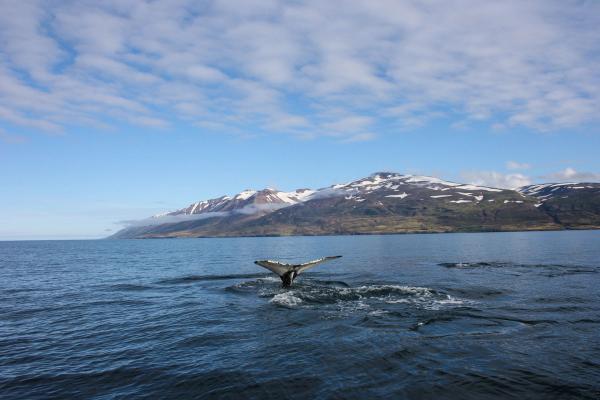
Horseback Riding
Apart from the puffin, the most charming animal in the country is the Icelandic horse. They are friendly and noble and quite easy to ride. Tours are available across the country, ranging from short rides to multi-day excursions. Popular locations for horseback riding include the South Coast, Snæfellsnes Peninsula, and around Lake Mývatn.

Take a Geothermal Bath
A visit to Iceland would be incomplete if you don’t enjoy one of the many geothermal baths in the country. Iceland’s geothermal activity has created numerous natural and man-made hot springs, perfect for relaxing after a day of exploring.
The most famous of them all is probably the Blue Lagoon. It’s located in Reykjanes, southwest Iceland, near Reykjavik. This iconic spa offers the chance to soak in milky-blue waters rich in minerals and other treatments.
If you’re going to explore the Golden Circle, a good idea would be to stop at Laugarvatn Fontana. Or, if you go to the north, the Forest Lagoon is a fantastic spa with incredible views.
Enjoy Reykjavík
Iceland's capital city comes alive during the summer, offering a mix of culture, cuisine, and nightlife. You can visit its most iconic monuments, like Hallgrímskirkja, the biggest church in the country. Or the Harpa Concert Hall, the heart of culture in the city.
There are several galleries and museums in Reykjavik with great exhibits about arts and history. For those interested in history, the National Museum of Iceland and the Saga Museum offer fascinating insights into the country’s Viking past and cultural heritage. If art is more your thing, Reykjavik is home to several contemporary art galleries, such as the Reykjavik Art Museum.
Laugavegur Street and the nearby area are the main commercial areas of the city and the country. It’s a vibrant hub for shopping, dining, and nightlife.
Reykjavík serves as an excellent base for day trips, but it’s also a great destination in itself.

Travel Tips for Iceland in Summer
- Plan Ahead: Summer is the peak tourist season, so accommodations and popular tours tend to book out quickly. Make reservations well in advance.
- Pack Smart: Icelandic weather is unpredictable, even in summer. Bring layers, waterproof clothing, sturdy hiking boots, and sunscreen for the long daylight hours.
- Rent a Car: While tours are available, renting a vehicle offers the flexibility to explore at your own pace. Choose the vehicle that suits your group and budget best.
- Follow Road Safety Guidelines: Some roads, especially F-roads in the highlands, require a 4x4 vehicle. Check road conditions on the Icelandic Road and Coastal Administration website before setting out.
- Respect Nature: Stay on marked paths, avoid disturbing wildlife, and leave no trace. Iceland's fragile ecosystem relies on responsible tourism.
Conclusion
Iceland is a fantastic destination in all seasons, but summer is the time when you can enjoy more things. From hiking the rugged highlands to relaxing in geothermal baths, and from whale watching to exploring vibrant Reykjavík, the season is packed with unforgettable experiences. With long days and warm weather, summer is the perfect time to immerse yourself in the magic of Iceland.









